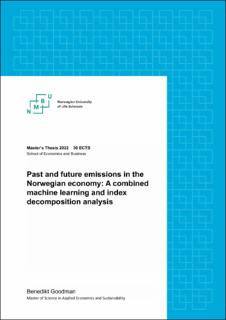| dc.contributor.advisor | Hung, Christine | |
| dc.contributor.advisor | Vik, Lars | |
| dc.contributor.advisor | Angelsen, Arild Einar Bjørn | |
| dc.contributor.author | Goodman, Benedikt | |
| dc.coverage.spatial | Norway | en_US |
| dc.date.accessioned | 2022-11-21T11:29:48Z | |
| dc.date.available | 2022-11-21T11:29:48Z | |
| dc.date.issued | 2020 | |
| dc.identifier.uri | https://hdl.handle.net/11250/3033120 | |
| dc.description.abstract | This thesis concerns the past and future emissions within the Norwegian economy. It employs retrospective analysis to analyse past sectoral emissions on a national level and supervised machine learning to predict emissions 5 years ahead for Norwegian municipalities. Policies addressing GHG-emissions have been on the agenda for over 30 years, yet sectoral emissions from Norwegian economic activity have risen 10.4% compared to the 1990-level. Most retrospective analysis carried out on emissions only analyses trends and tentative causes. Underlying drivers of emissions therefore remain unquantified, and their magnitude remains unknown. A logarithmic mean divisia index decomposition analysis is provided on sectoral emissions from 10 economic sectors in the period 1990 – 2019 alleviate the problem/provide answers on this area. The analysis shows that economic growth and worsening energy efficiency, particularly in the transport and petroleum & mining sectors, have contributed to a net increase of 6218 mktCO2e in emissions. Results also show that changes in economic structure, decreased usage of fossil fuels and increased carbon efficiency have worked as abating factors, but that they are outweighed by the factors which contribute to increase in emissions.
Given Norway’s ambition of curbing its own emissions by a significant degree by 2030 and then net zero by 2050. While these goals are specific only to certain types of emissions, it is still a somewhat open question as to how emissions might develop in the near future. A supervised machine learning analysis was carried out on GHG emissions from 354 municipalities in the period 2009 – 2019. An architecture using univariate linear regression tests for variable selection and extreme gradient boosting for prediction on a panelised dataset of emissions provided the lowest prediction error and projects that emissions from Norwegian municipalities will fall, reaching a level of 33 470 mktCO2e in 2025. | en_US |
| dc.language.iso | eng | en_US |
| dc.publisher | Norwegian University of Life Sciences, Ås | en_US |
| dc.rights | Attribution-NonCommercial-NoDerivatives 4.0 Internasjonal | * |
| dc.rights.uri | http://creativecommons.org/licenses/by-nc-nd/4.0/deed.no | * |
| dc.title | Past and future emissions in the Norwegian economy : a combined machine learning and index decomposition analysis | en_US |
| dc.type | Master thesis | en_US |
| dc.description.version | submittedVersion | en_US |
| dc.description.localcode | M-ECON | en_US |

